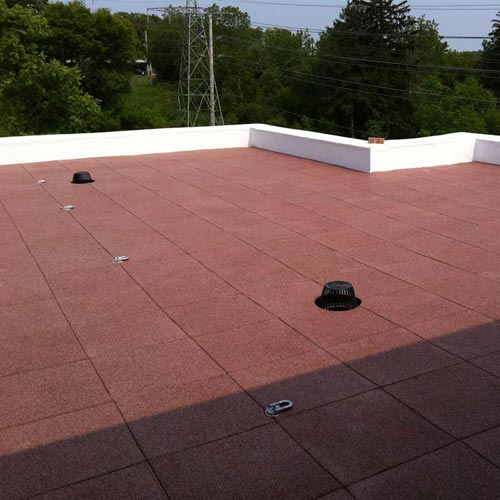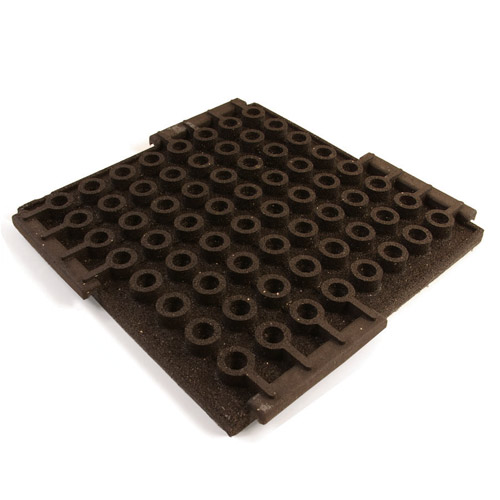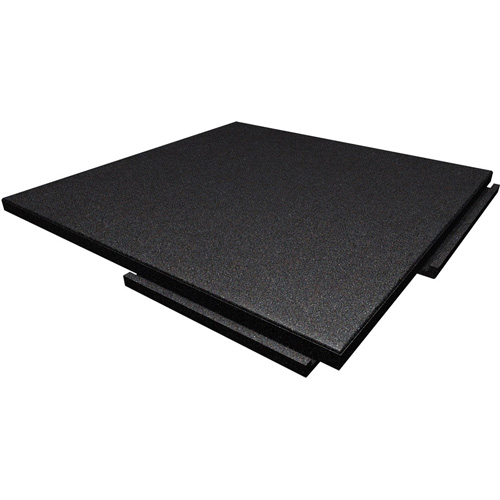Protective Rubber Roof Mats for Over Roof Top Membrane
Related Product: Sterling Roof Top Tile Black 2 Inch x 2x2 Ft.
What are Rubber Roofing Membranes?
Rubber roofing membrane is used on flat or nearly-flat roofs in order to prevent leaks and move water. Compared to asphalt and gravel roofing, roofing membrane has proven itself to be an advancement for roofing systems. Without seams, or with seams as strong as its entire body, roofing membrane remains leak and crack free throughout the entirety of its lifespan. If breakage does occur, rubber membrane can more easily be repaired than asphalt and gravel.Rubber Roof Deck Flooring and Roofing Membranes
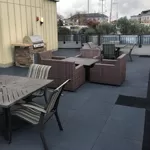 Places where rubber roofing membrane is used, such as on flat roofs or roof-top patios, are often turned into awesome patio areas. Elevated patio spaces can provide a luxurious outdoor sanctuary that rests above the chaos of the city and or the street. Creating a roof-top patio space is an excellent way to expand sought-after space in a home, condominium complex or apartment building.
Places where rubber roofing membrane is used, such as on flat roofs or roof-top patios, are often turned into awesome patio areas. Elevated patio spaces can provide a luxurious outdoor sanctuary that rests above the chaos of the city and or the street. Creating a roof-top patio space is an excellent way to expand sought-after space in a home, condominium complex or apartment building.
Before moving forward with creating a patio space, it helps to know about the harm rubber roofing membrane can face from such a project. Rubber roofing membranes are easily penetrable and are subject to damage by a variety of things. Debris, such as tree branches or rocks, can tear up roofing membranes. Certain types of patio flooring can also puncture or damage roofing membranes. Furthermore, roofing membrane is also susceptible to damage from furniture, foot traffic and high heels. Take informed precautions in order to protect your roof from leaks and your rubber roofing membrane from damage with protective rubber mats for rooftop membranes.
Rooftop Deck Flooring Needs
The right flooring is a key element in creating a fabulous roof top space. There exists a world of roof tiles and rubber roof mats that can turn a drab roof into an al fresco paradise. Aesthetics and design aside, roof tiles and protective rubber mats for rooftop membranes can help prevent costly damage and repairs. Roof tiles act as a barrier between heavy or sharp objects and rubber roofing membrane, thereby protecting membranes from tears and holes and ultimately, roofs from leakage.Safe Rooftop Deck Flooring Options
Many apartment and condo complexes will not allow flooring installations unless there is a no-damage guarantee. Fortunately, there are plenty of great options out there. The safest kind of rooftop flooring for rubber membranes include softer materials and lightweight options. However, you can also look for tiles that have enough base support to evenly distribute weight. That way, the underside of tiles will not dig into the membrane below. Here are a few examples:Rubber Roof Mats and Protective Rubber Tiles for Rooftop Membranes
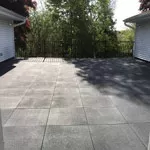 Rubber is a long-lasting and durable roof flooring option that comes in mat, tile and roll form. Outdoor rubber tiles and mats are tough enough to withstand weather, patio furniture and foot traffic. They are also thick enough to protect any underlying roofing membrane from damage. Despite its durability, rubber is smooth and lightweight enough that it will not create any tears or holes in rubber roofing membrane.
Rubber is a long-lasting and durable roof flooring option that comes in mat, tile and roll form. Outdoor rubber tiles and mats are tough enough to withstand weather, patio furniture and foot traffic. They are also thick enough to protect any underlying roofing membrane from damage. Despite its durability, rubber is smooth and lightweight enough that it will not create any tears or holes in rubber roofing membrane.
Rubber roofing mats/tiles are also a safe and affordable option. The grippy surface prevents slips and falls, even when wet. Rubber roof tiles and mats come in a variety of thicknesses, styles, and colors, so you can achieve an individualized look and feel for your patio.
Perforated PVC Flat Roof Deck Tiles
 Perforated roof tiles made of PVC are another quality, durable option for installing over rubber roofing membranes. Weighing around one pound per tile, they are an extremely lightweight option and will not damage underlying roofing membrane. The drain-through feature allow water to run through tiles instead of pooling and standing on top. PVC roof tiles come in a plethora of colors you can choose from to create a fun and bright environment.
Perforated roof tiles made of PVC are another quality, durable option for installing over rubber roofing membranes. Weighing around one pound per tile, they are an extremely lightweight option and will not damage underlying roofing membrane. The drain-through feature allow water to run through tiles instead of pooling and standing on top. PVC roof tiles come in a plethora of colors you can choose from to create a fun and bright environment.
